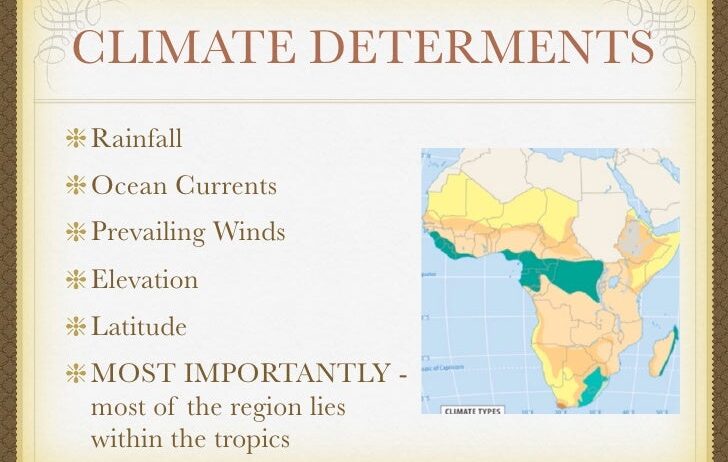Climate, a multifaceted domain of atmospheric conditions, diverges significantly across the globe, conferring upon every continent a unique ecological identity. In exploring the climates of Africa, Asia, and North America, one embarks on an enlightening expedition that not only unveils the inherent diversity of weather patterns but also accentuates the profound impact of climate on ecosystem health, human habitation, and socio-economic dynamics. This journey through climatic realms reveals an intricate interdependence whereby human activities are in constant dialogue with environmental conditions.
Starting with Africa, we traverse a continent characterized by a chromatic kaleidoscope of climates. This extensive landmass is primarily dominated by the tropical climate, particularly in the central regions where the equator penetrates. In these verdant zones, two primary seasons are experienced: the wet and the dry. The wet season—marvelous and bounteous—heralds copious rainfall, nurturing lush biodiversity, including the fabled Amazon-like rainforests of the Congo Basin. Conversely, the dry season can be a stark contrast, ushering in protracted periods of drought that challenge agricultural productivity and biodiversity alike.
Moving toward the northern reaches, one encounters the arid climates, typified by the Sahara Desert, which stretches majestically from the Atlantic to the Red Sea. This region embodies extreme temperatures, oscillating between blistering heat during the day and frigid conditions at night. The Sahara, often depicted as desolate, paradoxically harbors a range of life adapted to these harsh conditions. The resilience of both flora and fauna in such inhospitable environments raises questions about survival, adaptation, and climate resilience.
In addition to arid and tropical climates, the Mediterranean climatic zone manifests in the northern rim of Africa, characterized by hot, dry summers and mild, wet winters. This climate fosters the growth of diverse vegetation and has historically been pivotal in supporting flourishing agricultural societies. The contrasting climates of Africa illustrate the continent’s rich biodiversity and the complex interplay of its ecosystems.
Transitioning to Asia, a continent of staggering proportions, we find an equally diverse climatic repertoire. From the frigid tundras in Siberia—where winter temperatures plummet to extremes—to the tropical monsoon climates found in South Asia, Asia’s climatic zones reflect its geographical variety. The Himalayas serve as a formidable barrier, influencing weather patterns across the subcontinent. The southern regions, indulging in the tropical climate, are subject to monsoonal rains that invigorate agriculture yet create challenges with flooding.
In marked contrast, the northern expanses encounter continental climates, characterized by sharp temperature fluctuations between seasons. The significance of these climatic variations cannot be overstated; they dictate agricultural practices, influence urban planning, and shape cultural traditions. Nations like Mongolia, situated in the heart of this continental climate zone, demonstrate a lifestyle deeply interwoven with the rhythms of the natural world—and conversely, the immense pressures of climate change challenge their traditional ways of life.
Asia also houses the subtropical climates found in countries such as Japan and China, where temperatures are typically higher and precipitation can amount to substantial downpours during specific seasons. These regions cultivate rich ecosystems and biodiversity, showcasing the intricate dependencies between climate and human development. Some areas even experience phenomena such as typhoons, which introduce both destruction and renewal, prompting communities to adapt continually.
Shifting our focus to North America, we encounter a broad climatic spectrum extending from the Arctic tundra of Alaska to the subtropical climates of Florida. In stark contrast to Africa and Asia, North America exhibits four distinct seasons, often dictated by its latitudinal range. In the northeastern United States and southern Canada, the humid continental climate prevails, marked by significant snowfall and vibrant autumn foliage, highlighting nature’s adaptability to seasonal changes.
The southwestern regions of the U.S. invite desert climates with their characteristic aridity, where ecosystems have adapted to conserve water, evidenced in the unique flora and fauna of areas like the Sonoran Desert. The interplay between climate and human settlement in these regions raises critical questions about resource management and sustainability in the face of climate anomalies.
Furthermore, the Pacific Northwest revels in its marine west coast climate, adorned with lush forests that benefit from rich precipitation. This area, often shrouded in mists, serves as a cradle for diverse wildlife and a sanctuary for numerous ecosystems. Such climatic variations underscore the relationship between climate, ecology, and human habitation.
In conclusion, the climates of Africa, Asia, and North America present a multitude of landscaping ecosystems and vibrant communities. The distinct weather patterns not only shape the environmental characteristics of these continents but also influence societal development and cultural practices. As the looming specter of climate change increasingly encroaches upon these intricate climatic systems, understanding their diverse narratives becomes imperative. This synthesis of climate and culture illustrates that we are all interconnected, and it highlights the urgent need for innovative strategies that harmonize human intervention with the natural world. The future hinges not just on witnessing these climatic phenomena but actively engaging in constructive conversations about sustainability and environmental stewardship. As stewards of our planet, acknowledging and adapting to the distinct climates of Africa, Asia, and North America is crucial for conserving human heritage and ecological integrity.








